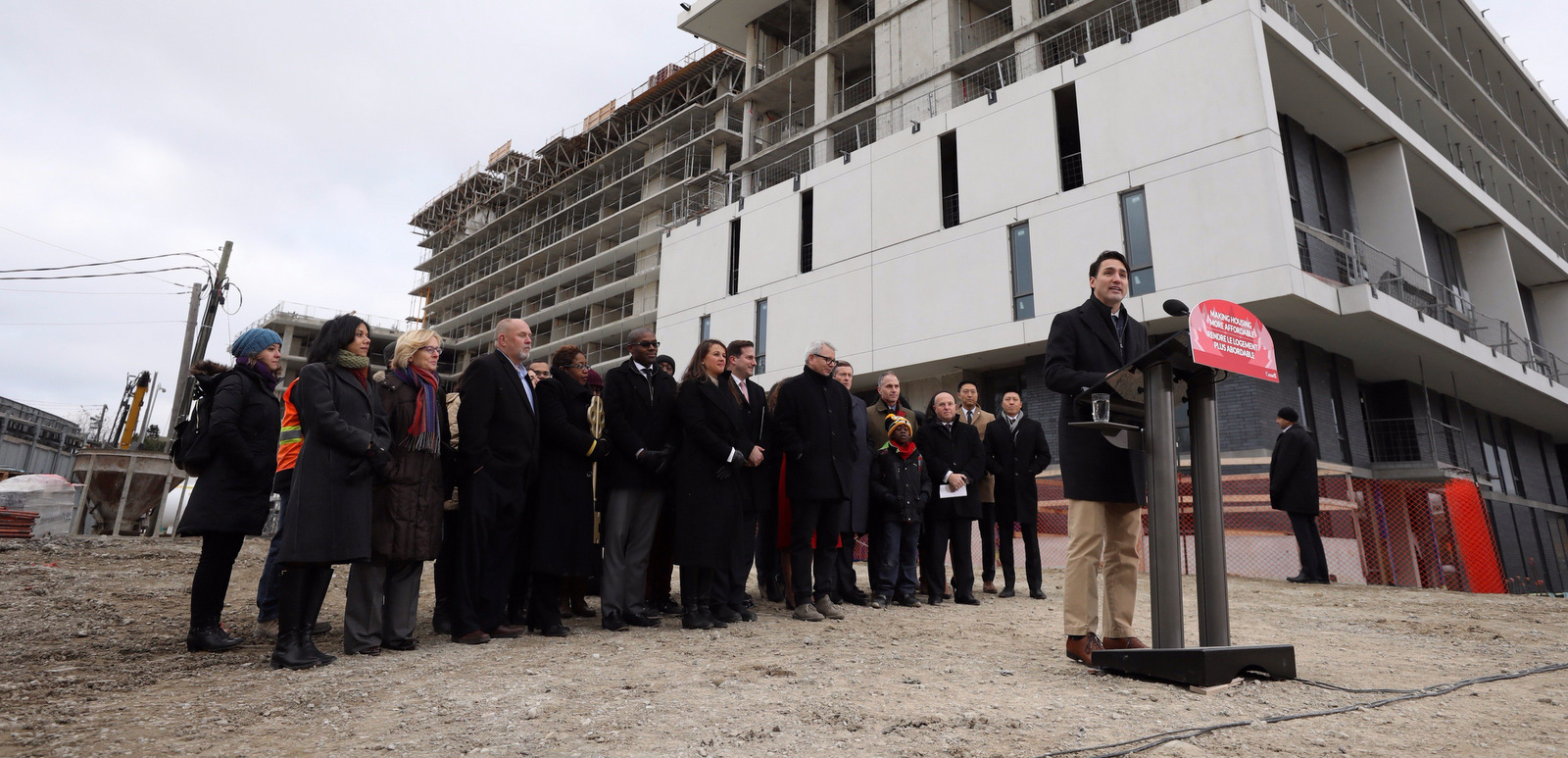OTTAWA, CANADA — While U.S. lawmakers debate a Trump administration tax cut that will inexorably deepen the bone-deep budget cuts that have been eroding American living standards for nearly 40 years, Canadians are going on a bit of a spending spree.
Quebec’s Premier this week proposed a guaranteed minimum income of $14,000 annually for disabled adults as part of the provincial government’s $2.4 billion effort to combat poverty. Last week, Ontario’s transportation minister said his agency would double public spending on new bike lanes from $35 million to $70 million. And last month, the leader of Ontario’s conservatives said that if his party, the Progressive Conservatives, is elected next June, lawmakers will provide parents with an annual subsidy of $5,256 per child to offset soaring childcare costs.
Just the day before the Tories unveiled their campaign platform, the Liberal Party’s Prime Minister, Justin Trudeau announced that his administration would invest $8.72 billion to build or repair 400,000 units of affordable rental housing over the next decade, as part of the federal government’s initiative to ultimately reduce Canada’s homeless population by half.
In September, provincial leaders in British Columbia called a press conference to gleefully correct earlier forecasts of $2.4 billion in new social spending on health care, K-12 education and affordable housing. The finance minister was happy to inform reporters that the province was actually on course to spend $1.5 billion more than initially anticipated.
“It’s a budget that puts people first,” said the minister, Carole James. Not to worry, however, as the expenditures are to be fully funded with a tax increase on personal incomes of more than $117,000 annually, from 14.7 to 16.8 percent, and on corporations, which will see their rate inch up from 11 to 12 percent.
An end to economic mimicry


Prime Minister Justin Trudeau, center, announces the Liberal government’s National Housing Strategy in Toronto, Canada, November, 22 2017. (Twitter/@JustinTrudeau)
What’s happening here in Canada is the phasing out of a ruinous national experiment in austerity that took its cue from the default position of the political class in the United States for two generations and counting. The GOP’s tax proposal is merely the last of a thousand deadly cuts inflicted by both Republicans and Democrats since Wall Street effectively organized a coup and assumed responsibility for New York City’s budget in 1975.
Conversely, Canada didn’t abandon the consensus that shaped North America’s postwar prosperity until 1995 in the aftermath of a deep recession. In his 1994 budget speech, the Finance Minister Paul Martin — who would go on to succeed Jean Chretien as Prime Minister in 2003 — introduced a landmark budget that mirrored the Clinton Administration’s own deficit hawkishness:
It is now time for government to get its fiscal house in order. For years, governments have been promising more than they can deliver, and delivering more than they can afford. That has to end. We are ending it . . . Over the next three years, for every one dollar raised in new revenues we will cut five dollars in government expenditures.”
Canada’s Liberal Party went on to slash the spending of virtually every federal department over a three-year span, reducing government expenditures by more than $19 billion – including nearly $6 billion in federal transfers to the provinces for health and education — and eliminating 45,000 public-service jobs. Conservative Prime Minister Stephen Harper followed the Liberals’ 13-year deficit-reduction scheme with nine years of his own.
The Trudeau government’s gradual restoration of government infrastructure investments — combined with the Conservatives’ embrace of increased government spending — represents a political response to cost-cutting measures that have proven deeply unpopular with Canada’s electorate, and a blunt acknowledgement that budget cuts, far from energizing an economy, sap it of the buying power it needs to grow.
“Our government will not repeat the ideological cuts of the former Conservative government,” a spokesman for Canada’s Treasury Secretary told reporters, to defend adding more than 3,700 new workers to the government payroll this year.
Political traditions driving economic policy


Family members are helped into Canada by Royal Canadian Mounted Police officers along the U.S.-Canada border near Hemmingford, Quebec. (Canadian Press via AP)
Polls show that nearly two-thirds of Americans disapprove of President Donald Trump’s tax proposal, which will surely double down on the Reagan Administration’s discredited trickle-down economic theory. So why is it that political support for austerity measures in the U.S. remains impregnable while their governmental counterparts just across the northern border are denouncing laissez-faire economics like the plague?
The answer can be found in the differing political traditions of the two neighboring nation states, said Bryan Evans, director for the Centre for Policy Innovation and Public Engagement at Toronto’s Ryerson University.
Ask any indigenous or Caribbean person living here and they will surely tell you that Canada is no racial utopia. But neither is it as deeply invested as is the United States in polarizing tribal narratives that undermine working-class solidarity, and allow the country’s wealthiest one percent to divide, and conquer, everyone else.
Take the province of Ontario for example. Of a total workforce of roughly 8 million people, 1 million are employed in the public sector. Inevitably, said Evans, few households are untouched by government layoffs. “That’s my daughter, that’s my nephew, that’s my wife,” said Evans, describing Canadians’ typical response to provincial budget cuts.
While genocide of Native Americans was central to Canada’s colonial enterprise, the country’s relatively small population — 37 million people, according to the most recent Census figures — and abundant land meant that white settlers never relied on the triangular slave trade as much as did other colonial enterprises in the New World, such as Brazil or Haiti or, of course, the U.S. Consequently, Blacks never represented much of a threat to the landowning elite, either through violent slave revolts or as the most consistently liberal voting bloc in elections in which whites are often evenly split.
The banks’ takeover of New York City’s finances in 1975 is a case in point. As the historian Kim Phillips-Fein and others have noted, New York’s fiscal crisis, which began in 1973, was largely the result of exuberant real estate speculation and crony capitalism that awarded increasingly lucrative contracts to political donors. Wages were high, especially in the public sector, causing inflation to spike, but workers and their employers tend to view rising prices in sharply different ways. Economists say that moderate levels of inflation don’t impact economic growth, but an annual inflation of 5 percent means that a $100 loan this year is worth only $95 next year. Unsurprisingly, borrowers are unbothered by such a prospect while creditors often view price instability as a type of fraud.
“Donald Trump wouldn’t be possible here”


Prime Minister Justin Trudeau greets members of a Syrian refugee family during Canada Day celebrations on Parliament Hill, in Ottawa, July 1, 2016. (Justin Tang/The Canadian Press via AP)
Yet, in making their case to white labor leaders and Democratic politicians, financiers portrayed African-Americans and Latinos in the public sector trade unions as reckless, selfish, and unpatriotic. Repeated endlessly as if on a tape loop — in vehicles such as the 1915 classic film, Birth of a Nation; the political consultant Lee Atwater’s campaign ads stoking fears of the black sexual menace; or Hillary Clinton’s depiction of the “super-predator” — such racist appeals have been seen to drive U.S. politics but simply don’t go over in Canada.
“Donald Trump wouldn’t be possible here,” said Evans. “In Canada we’ve had that tradition where government is not a dirty word. We do have our moments where we lurch to the right to fix a crisis but then everyone gets over their anger and says, ‘what have we done here?’”
The result is that Africans, Arabs and Asians tend to regard Canada far more favorably than they do other countries governed by European settlers. A 30-year-old South African refugee who fled political violence in Cape Town’s taxi industry and lived for awhile in North Carolina, before arriving in Toronto earlier this year, told me that “there is racism here, but the white settler in Canada is a better class of white settler than you’ll find either in America or South Africa.”
That said, there is a feeling among Canadians of a certain age that the damage done by neoliberalism is irreversible, even if not as severe as that done to the United States. The role of the financial sector in the economy is as outsized in Canada as it is in the U.S. and — while efforts to privatize education or shortchange the country’s famed universal health care system seem unlikely — labor is being increasingly casualized.
“I have a nephew who has a college degree and has done everything right, and his big ambition is to be part-time permanent,” said Evans. “There is a feeling in Canada that our best days are behind us.”
Top photo | President Donald Trump walks with Canadian Prime Minister Justin Trudeau along the Colonnade to the Oval Office at the White House on Oct. 11, 2017. (AP Photo)
Jon Jeter is a published book author and two-time Pulitzer Prize finalist with more than 20 years of journalistic experience. He is a former Washington Post bureau chief and award-winning foreign correspondent on two continents, as well as a former radio and television producer for Chicago Public Media’s “This American Life.”
<!–
–>
Source Article from http://www.mintpressnews.com/as-trump-and-gop-further-eviscerate-us-public-sector-canada-stops-imitating/235553/
 RSS Feed
RSS Feed















 December 15th, 2017
December 15th, 2017  Awake Goy
Awake Goy 
 Posted in
Posted in  Tags:
Tags: 













